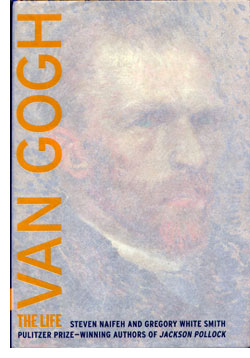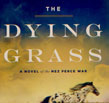 |
 Steven Naifeh and Gregory White Smith
Steven Naifeh and Gregory White Smith
Van Gogh: The Life
Random House
US Hardcover First Edition
ISBN 978-0-375-50748-9
Publication Date: 10-18-11
960 Pages; $40.00
Date Reviewed: 12-31-2011
Reviewed by: Rick Kleffel © 2011
Index:
Non-Fiction
The very title of the book is audacious. The project planning seems almost insurmountable, even if the subject were a contemporary man of no accomplishments. After all, how to capture "a life" in non-fiction? There's definitely a "Heisenberg uncertainty effect" in biography; observing the subject changes him or her, perhaps in the same manner as pinning a live butterfly to a canvas background. The subject remains beautiful, but dies.
If the subject is an artist, then the death of both the subject and their beauty seems all but assured. On one hand, if you are writing non-fiction, you must by definition, stick to the facts of the matter. On the other, if you are trying to re-create a human life, the facts alone simply will not do. Even if the subject is not an artist, the biographer(s) must use art to bring the subject from history into story — into narrative. Humans are, after all a narrative species, roughly speaking, a right-hand side of the brain that observes the facts, and a left-hand side of the brain that assembles them into story.
'Van Gogh: The Life' manages the breathtaking success it achieves, living up to the subject, creating the life of the artist by virtue of the fact that the team who wrote it comprise a sort of gestalt entity, a left and right half of the brain that can properly assemble and bring life to those whom it observes. Steven Naifeh is the researcher, the observer, who records the facts and hands them to Gregory White Smith, the storyteller. Of course, as in the human mind, there's clearly got to be a lot of cross-talk, cross-over, back and forth, but the result, as in our human experience, is a single, unified narrative that as much as possible compellingly, engagingly creates, in a reading experience, the life of Vincent Van Gogh. Not surprisingly, given the effort and artistry on display here, the work in prose rivals the best of its subject's work.
'Van Gogh: The Life' clocks in at 879 reading pages, with about a hundred pages of notes in the book itself. Remarkably, the rest of the research, over 6,000 pages, is available online, at Van Gogh: The Life Biography. But here's the question you, the potential reader have to ask yourselves, and it is an important question, to be sure: Is this enormous book worth your valuable reading time? What is the compelling draw to pull you through nearly 900 pages? It's as long as a Tom Clancy or Stephen King novel, and does not involve time travel or blowing up the Kremlin.
But the mystery here is every bit as compelling as the Kennedy assassination, and the narrative pull more engaging than blowing up the Kremlin. The impact that Vincent Van Gogh had upon this world, the beauty and joy and sadness he expressed in his art is universal. It needs no translation. The power is undeniable. How did these paintings, these images come into this world? 'Van Gogh: The Life' can and should be read as a page-turning mystery. How did this odd-looking, mentally ill young man create images that may well last beyond what we politely call modern Western civilization? His life, we come to discover, was an absolute mess. But from it emerged starry nights and self-portraits that sear our souls.
Soul-searing is relevant in this work, and in this life. Van Gogh always lived beyond his means, always pushed to the extremes. Naifeh and Smith give us every detail that we need, and that's a lot of detail, but no more. We meet his grandparents and parents, his mother in particular. Then we're off into a life of grit, failure, compulsion, family, mistakes, sex, disease and art. White's prose is precise and passionate. You'll need to remind yourself that you're reading non-fiction, as White has a talent for immersing you in character arcs and plot points that is very novelistic. But all those great details, the plot points that amaze you — his faux-marriage to a prostitute, an intense set piece that takes place after a devastating mining disaster — as unearthed by Naifeh, are the stuff of corroborated fact, and literally years of research.
Naifeh and Smith were given access to papers and letters that have not yet been integrated in the manner of this work, and the depth they add is clearly important, both to our understanding of Van Gogh and the readability of the book. 'Van Gogh: The Life' lets us walk in his parents' shoes, feel their love for him, their exasperation with him. This is a book that many parents will find particularly poignant; Van Gogh was a hard-knocks guy, and he usually set himself up. There were certainly mental illness issues that tugged him down, and the authors document this but do not dwell on it. They have a different vision of his death than the standard-issue, which has made headlines. Well it should, but the point of the book is that as a reader, you get to know Van Gogh, and by the time the revelation is made, readers will have made that leap themselves, by virtue of how deeply we are invested in his character.
While we do get to literally live Van Gogh's life, Naifeh and Smith make that life come to life by giving us the properly shaded vision of those who surrounded Van Gogh. These characters — his family, his friends, some famous, some not — figure into plot arcs that keep the pages turning as fast possible to bring readers to those penultimate moments when Van Gogh literally changed the world. It's every bit as earth-shaking as any fictional construct and grippingly-plotted in this well-constructed biography.
Reading 'Van Gogh: The Life' is not a trivial investment of the time you will spend in this life. Give it an hour a day, and you'll easily finish it in a month. The return is two-fold. The satisfaction of joining Van Gogh as he realizes a success that will go unrecognized while he is still alive is palpable, tremendous. It is a moment before the moment. When you see his works, you will know the man, and know the works; "As my work is, so am I."
But the success of the biography is that readers will know more than the man and his work; they will know the world, their world, this world, as Van Gogh knew his, to the extent that is possible. You will see a starry night, yourself in the mirror, fields in the sun, and know that terrible beauty there, in our own hearts.
|
 |




